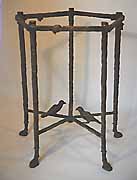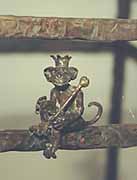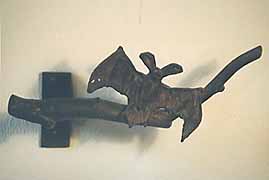Creativity
is an "All in the Family" thing, as the sister of this month's
featured designer bears proof of in our Gallery story.
By Rita Vainius
In concert with our "All in the Family" theme, our gallery
spotlight focuses on Barbara Greenberg, sister of Charland Garvin, our
featured designer. Barbara collaborates with her sister in designing sterling
silver "tokens", Charland's signature trademark. Another family
member, with an artistic bent is Charland's son, Chris, who has also designed
some of the charms which embellish her samplers. Charland considers herself
very fortunate in having two artists to work with, who know her so intimately,
that they can anticipate her design preferences. How this combination of
talents evolved is revealed in Charland's story, but Barbara also has a
revelation which may come as a surprise to stitchers who are familiar with
Charland's work! Her unique designs often hold a secret message or "sign,"
charted- in surreptitiously: "XMAS" is hidden in the ChristmasSampler,"T42"
in the Tea For Two.

Just like her sister, but 8 years later, Barbara was born in Montana. Their
father was a cattleman and their mother a homemaker. Both learned stitching
skills as children as did most other girls they knew. From their early
beginnings, their lives diverged radically. It always comes as a surprise
to Barbara that, even though each of their life experiences have been so
different, they share much common ground.
Barbara left Montana to attend Bennington College in Vermont, where she
majored in literature but found herself devoting just as much time to studio
arts: painting, color theory and sculpture. After graduating, she taught
herself to weave. Barbara was fascinated by how some colors seemed richer
woven with fiber, than using paint, while others felt flatter. Her curiosity
was further aroused when she discovered some rugs from Poland that handled
color in a very distinctive way. So intrigued was she, that she made a
pilgrimage to their source.
The winter of 1974 found Barbara in the Polish mountains at a craft cooperative
where the mystery was revealed. Each area of the rug that was seemingly
one solid color was actually composed of threads dyed in several different
variations of that one color, ie. each red was made up of many threads
of different hues of red blended together during the weaving process. This
technique accounted for the dynamic intensity of each color.
After this sojourn, Barbara was invited to spend a semester at a tapestry
atelier in Krakow, where she met Magdalena Abakanowicz, the renowned fiber
artist. The lessons she learned have stayed with her: "Magdalena talked
about space and time as if they were tangible things you could move around
with your hands. She also said that color is nothing without a form,"
Barbara recalls. This second lesson began to take on new meaning when Barbara
made only black or brown weavings for two and a half years! During her
last year in Poland, Barbara met Pawel Kromholz, a painter and sculptor
who was a rising star among his peers. They married in 1977. So well did
Pawel know her, that the first gift he presented Barbara with, was a bat
skull!
The following year they traveled to Denmark where each had exhibitions.
Barbara's weavings had been transformed into massive fiber sculptures,
measuring 8 to 10 feet in length and, when suspended from the gallery ceiling,
floated and curved into shapes subtly affected by air currents. They were
woven on a linen warp with the weft consisting of dyed sisal, mostly monotone
in color. She also displayed some loose structures of twigs, held together
with copper wire and string, creating various forms.
 After
this interlude, they moved to New York. Barbara continued to experiment
with wire, branches, twine and rags. Three years later she was appointed
artist-in-residence at Stanford University in California where she was
able to work outdoors and to sculpt in bronze. A highlight of her tenure
there was a sculpture she made composed of small saplings, wire, rags and
twine. When completed, it was appropriately named "Nest Comes to Rest",
as it was so large it had to be transported to the Museum lawn by helicopter.
Another work called "Hill Project" was made up of plastic and
rubber highway markers meandering single file, following the contours of
the landscape and converging at some spots in clusters. These installations
were site specific works and not intended by Barbara to be permanent, as
stated in her contract with the University which specified that they could
be removed when they became either unsightly or unsafe.
After
this interlude, they moved to New York. Barbara continued to experiment
with wire, branches, twine and rags. Three years later she was appointed
artist-in-residence at Stanford University in California where she was
able to work outdoors and to sculpt in bronze. A highlight of her tenure
there was a sculpture she made composed of small saplings, wire, rags and
twine. When completed, it was appropriately named "Nest Comes to Rest",
as it was so large it had to be transported to the Museum lawn by helicopter.
Another work called "Hill Project" was made up of plastic and
rubber highway markers meandering single file, following the contours of
the landscape and converging at some spots in clusters. These installations
were site specific works and not intended by Barbara to be permanent, as
stated in her contract with the University which specified that they could
be removed when they became either unsightly or unsafe.
 Back
in New York, Barbara made a table using twigs, some from nature and others
cast in bronze. She discovered that she could make a much more graceful
piece of rustic furniture using only bronze, as thinner bronze branches
could support more weight than actual wood. Pawel was then working as a
conservator of classical antiquities and many Greek, Roman and Etruscan
treasures made their way through their studio. Barbara's work began to
reflect this classical influence.
Back
in New York, Barbara made a table using twigs, some from nature and others
cast in bronze. She discovered that she could make a much more graceful
piece of rustic furniture using only bronze, as thinner bronze branches
could support more weight than actual wood. Pawel was then working as a
conservator of classical antiquities and many Greek, Roman and Etruscan
treasures made their way through their studio. Barbara's work began to
reflect this classical influence.
In 1991, Pawel and Barbara returned to Europe settling in Holland, where
they continue to make art. Pawel does portrait drawings, painting and figurative
bronzes. Barbara makes bronze furniture, still very classicly influenced.
Pieces of her recent work, which are all one-of-a-kind, include console,
side and coffee tables, chairs and candelabra. These are often populated
by creatures culled from the Fables of La Fontaine, the French fairytale
master. On the rung of one table regally sits the monkey king, sent by
Jupiter to sort out a fight between the elephant and the rhinoceros, whose
figures appear on other parts of the frame. Birds, bats, frogs, deer and
rabbits scamper among the bronze "branches" of others. A dog's
head forms the fulcrum on a chair. Barbara's talent lies in creating practical
everyday items imbued with elegance and a magical whimsy which holds one
spellbound.
Barbara and Pawel collaborate together on some
projects, especially commissions and door and cabinet hardware. Examples
of these are an artichoke doorknob and a branch supporting a bat about
to take off in flight, which when affixed to a mantle holds a set of fireplace
tools, also sculpted by them.

Pawel and Barbara had their first child, a son they named Ivo, in 1981.
She refers to the decision to become a parent as the triumph of optimism
over better judgement! Optimism won out again in 1988 when Sophie was born.
Charland refers to Barbara as the "real" artist of the family.
In saying so, she is referring to the quality and level of intensity of
her sister's commitment to her work. "I would die for art," Barbara
asserts which absolute conviction.
Barbara's and Pawel's work is sold through galleries and decorators in
Belgium and in the Netherlands. Barbara also sells Charland's "jewelry"
to the trade in Europe. She can be contacted by writing to Greenberg &
Krumholz, Hertogsingel 2, 6214 AD Maastricht, The Netherlands or by phone
at (31) 43-321-7891
